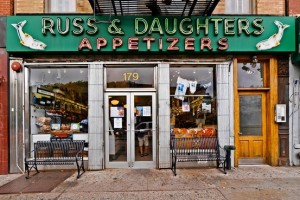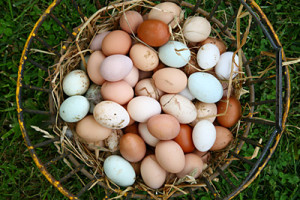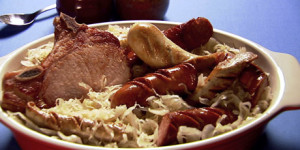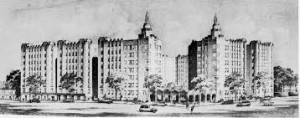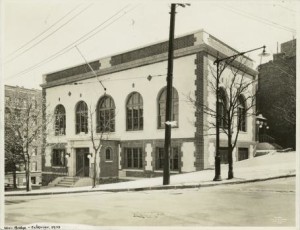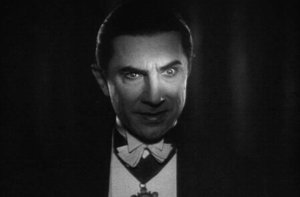Once upon a time, many years ago, there was an affordable, funky, comfortable city known, then and now, as New York. Among the city’s many amenities was the “appetizing store.” This was a small store that sold smoked fish (Nova Scotia salmon, salty lox, sable, sturgeon, kippered salmon, herring, whitefish); olives (green and black); pickles (from a barrel), cole slaw, potato salad. On the shelves were canned and jarred items such as salmon, tuna and anchovies. Some stores offered dried fruits, nuts and halvah. “Appetizing stores” were omnipresent on every shopping street in the Jewish neighborhoods of Manhattan, The Bronx , Brooklyn and Queens. Today, only two survive: Russ & Daughters on the Lower East Side and Murray’s Sturgeon Shop on the Upper West Side. (Yes, there are two big time smoked fish landmarks on the Upper West Side: Zabar’s and Barney Greengrass. But, Zabar’s is a megaplex offering housewares, cheese, prepared foods, breads, sweets, etc. Greengrass is as much a restaurant as it is an “appetizing store.”) R & D and Murray’s have loyalists. SJ insists that R & D has the ultimate smoked fish and salads. Others think Murray’s experienced hand slicers are accomplished artists. HG leans toward R & D but finds Zabar’s sable and red salmon caviar superior. HG has heard that Murray’s has become a bit moldy. R & D, on the other hand, has become reinvigorated with an energetic younger generation that has taken over and expanded the Russ & Daughter’s brand. In HG’s youth, it was HG’s Sunday task to shop at the “appetizing store” on Kingsbridge Road in the Bronx and bring home the fixings for the joyous Sunday brunch. It was the job of the father of the household to visit the neighborhood bakery for the essential bagels, bialys, pletzels and rye bread. Moms took care of the cream cheese, sweet butter and sour cream. In the immediate World War Two years, a certain casual jacket became popular among Jewish men. A four button affair, it had a tweed body and camel hair sleeves. It was designed for weekend casual activities. It was known as the “Bagel Coat” because it was the obligatory costume of men fetching those baked (but first boiled) treats.
The Appetizing Store
October 31st, 2015 § 0 comments § permalink
Eggs
October 29th, 2015 § 0 comments § permalink
Poached eggs. Scrambled eggs. Omelets. Those are the ways HG likes eggs prepared. Never liked fried eggs. Never a fan of the ubiquitous New York fried egg sandwich. HG likes to eat eggs at home because that’s where they are prepared perfectly. BSK is a talented poacher. BSK poached eggs always have soft (but gently firm) whites and lush, runny yolks. BSK enjoys them on French bistro salads of frisee and bacon or topping a bowl of buttery and cheesy grits. (Poached eggs are splendid served with corned beef hash but HG hasn’t encountered a good restaurant version of this hash since the wonderful Longchamps restaurants of New York closed years ago [SJ here…The Corned Beef Hash topped with a fried egg at Keen’s Chop House is pretty much killer!] ). HG likes ultra soft scrambled eggs with gentle, creamy curds. Impossible to find such eggs at diners and other casual breakfast eateries. They must be made at home with plenty of butter sizzling in the pan (Adding sweet cream is an option). Long deft stirring is the secret. Takes time. The Alice Toklas (Gertrude Stein’s companion) recipe for scrambled eggs suggests 30 minutes of stirring. That’s excessive. The HG family Christmas season late breakfast treat is soft scrambled eggs topped with red salmon caviar and creme fraiche (or sour cream). A warm buttered bialy goes nicely with this holiday treat. HG likes omelets with soft creamy interiors. HG has learned the secret of ordering omelets in Paris. HG orders them baveuse. The translation is “oozing.” BSK and SJ are masterful omelet cooks. HG likes his with a filling of feta cheese. (Pete’s Diner in Denver, home of the world’s greatest giant breakfast burrito, makes a quite acceptable version of this omelet). Yes, BSK and SJ make delicious omelets. But, the Queen of Omelets was a stern, unsmiling Frenchwoman, Mme. Romaine de Lyon. She ran an eponymous omelet restaurant (served only omelets) on New York’s Midtown East Side for some 65 years. How to describe her wondrous omelets? Exquisite. Lush. Divine. Yummy. Many famous folk dined at the restaurant. Anne Bancroft and Mel Brooks were regulars. Brooks wrote the screenplay for The Producers (the movie with Zero Mostel and Gene Wilder) at his regular table at Mme. De Lyon’s restaurant. If you want to learn the secrets of omelet cooking read Mme De Lyon’s book, The Art of Cooking Omelettes. She spells the dish with two t’s and the book contains 500 savory recipes.
Choucroute Garnie
October 28th, 2015 § 2 comments § permalink
Choucroute simply means sauerkraut. Choucroute Garnie (on French brasserie and bistro menus) is sauerkraut cooked with a variety of pork products. Chez Jenny in Paris has always been touted as a great place for Choucroute. HG disagrees. The Paris best is Brasserie de I’Isle St. Louis. Despite a touristy location near Notre Dame, the brasserie turns out serious, old fashioned French food. Dedicated foodies say that to taste real choucroute one must travel to Alsace. HG is not that dedicated and likes BSK’s home cooked choucroute. BSK rinses a jar of Bubbie’s sauerkraut and cooks it with onions, juniper berries and white wine (SJ notes that a nice Riesling is the preferable choice). Adds Kassler Rippchen (German smoked pork chops from Schaller & Weber online) and knockwurst. Serves it with boiled potatoes, French cornichons and Keen’s English Mustard. Noted food writer Jeffrey Steingarten attempted to codify the ingredients of Choucroute in his wonderful book The Man Who Ate Everything, but one of the joys of making the dish at home is going to a good German/Polish/Alsace butcher (SJ reccomends Jubilat Provisions for Brooklyn folk) and picking out numerous yummy things. Cold beer or ale with a shot or two of chilled vodka are the obligatory beverages.
Part Three: Early Bronx Memories (More Woodycrest)
October 26th, 2015 § 0 comments § permalink
One of HG’s sharpest Great Depression memories (circa 1935-37) is of clusters of men gathered each day in front of 1210 Woodycrest Avenue, the Bronx apartment house where HG and family lived. The men were dressed in coats, suits, shirts and ties, shined shoes, fedora hats. That’s the way men dressed in those days. Sportswear hadn’t been invented and only cowboys or laborers wore jeans.They smoked cigarettes. They were unemployed but neatly dressed in case a job interview came up. Unlikely. But, they were prepared. A grim time. HG’s older brother, Bernard, found a job as a bartender at the Topps restaurant on W. 42nd Street. Then he worked in the stock room of a luggage manufacturer. Bernard was always unlucky, a rat bit him and he became the last recorded typhus victim in New York. Later he worked as a salesman in the fur district. Saved money. Studied optometry at Columbia. Became an optometrist and lived and practiced optometry in Atlanta from 1941 until his death a few years ago (Some 14 years older than HG, he was proud that he supplied eye glasses for Dr. Martin Luther King, Dr. King Jr’s father–who he called “Daddy” King–and all other members of the King family and their congregants). In 1937, HG’s late sister, Beulah Naomi, graduated high school at the age of 15 and immediately went to work as a bookkeeper for a fur coat manufacturer. At night she attended City College of New York at the 23rd Street branch (now known as Baruch College). The family weathered the Great Depression. The Spanish Civil War began in July 1936. Politically left wing (but not Communist), HG’s family supported vigorously the Loyalists who battled the Fascists. Some of HG’s brother’s friends joined the Abraham Lincoln Brigade and went to Spain to fight. Little HG was shocked by the bombing by German and Italian warplanes of the Basque village of Guernica. The vision of death from the skies haunted HG. Picasso, of course, responded to the bombing by painting Guernica, his huge, moving anti-war work of art. (Completed in 1937). In later years, HG always viewed Guernica at New York’s Museum of Modern Art. Very moving. Viewed Guernica again after it was moved to the Reina Sofia Museum In Madrid. HG and BSK agreed, It still had a powerful impact.
Woodycrest Avenue (and much of The Bronx) began to deteriorate in the 1960’s and by the 1970’s became dangerous and decayed. In the 1970’s HG’s public relations firm was retained by a Bronx-based elevator repair and maintenance company. It became HG’s mission to dramatize the dangers of the elevators in bedraggled Bronx apartment houses. The aim was to force the city to enforce vigorously safety codes regarding elevators. Of course, this would mean increased business for elevator repair and maintenance firms. At the time, HG worked closely with Carl Stokes, the African-American ex-Mayor of Cleveland and then an NBC-TV anchorman and reporter. The elevator story that Stokes reported on for NBC centered on HG’s childhood home, 1210 Woodycrest Avenue. The place was in desperate shape. Glass doors had been replaced by plywood sheets smeared with graffiti. The lobby was filled with debris. Corridors were filthy. The elevator barely functioned. The program created action. Elevator inspections and enforcement became more frequent in The Bronx and other boroughs.
At the time, Woodycrest Avenue was the home of a folk hero, idolized by some of The Bronx’s impoverished African-American population. He was Larry Davis, an alleged murderer and drug dealer. Davis, his mother, brothers, relatives and a group of friends lived in a frame house on Woodycrest. (Many of the inhabitants wound up in prison). In 1986, Davis was at his sister’s home in the East Bronx. Davis was wanted for murder. Six police officers burst into the apartment. Davis answered with gunfire. A number of officers were wounded (some seriously) before he was captured. At his trial, Davis was represented by William Kunstler, a flamboyant attorney who represented many left wing radicals and anti-Vietnam War activists (including the
Woodycrest and its environs have changed through the years. It is now a Dominican neighborhood with some Puerto Rican and African-American residents. Much of the housing has been renovated (including 1210). Two architectural landmarks in the art deco style have been preserved and revitalized. They are the eight-story Noonan Towers (939 Woodycrest Avenue) and the remarkable group of buildings, Noonan Plaza on W. 168th Street. Both were built in the late 1920’s by developer Bernard Noonan. The Noonan Plaza complex was little HG’s vision of paradise. It was entered by a gate manned by an imposing fellow with a colorful cape. The buildings were white brick art deco. The courtyard had a waterfall, streams adorned with Japanese bridges and graceful swans who glided on he water. HG visited Noonan Plaza with HG’s sister (a high school friend lived there). HG was astonished by the big living rooms, bathrooms with colorful tiles and built-in tubs, kitchens that were the height of Moderne. Tragically, Noonan Plaza disintegrated. But, fortunately, the city stepped in before it disappeared. A very ambitious restoration program made it sought after housing for lower income families. No, the swans and waterfall are gone. But, Noonan Plaza lives. HG doesn’t know what has happened to another great art deco masterpiece in the neighborhood, the Park Plaza apartment house on Jerome Avenue. Built between 1929-31, it faces Mullaly Park. Its facade is adorned with remarkable gargoyles and terra cotta plaques. The architect was the late Horace Ginsbern who designed some 137 Bronx apartment houses as well as many Manhattan buildings. The late Julien J. Studley, who loved architecture (HG wrote about him recently), bought the building at one point. Fascinated by its design, Julien, an optimist, thought he could effectively maintain the building despite the strictures of rent control. He was wrong. Quickly sold the building. The Woodycrest neighborhood is improving (still a bit dangerous, however). At one time, it was composed of estates where the gentry rode to the hounds. Woodycrest Avenue was part of the Marcher estate. The Marchers loved Shakespeare and created formal gardens with busts of Shakespeare and characters from his plays. All that remains of their interest is Woodycrest’s neighboring street: Shakesepeare Avenue.
Part Two: Early Bronx Memories (Woodycrest Avenue)
October 25th, 2015 § 0 comments § permalink
The year was 1935. Not a happy year for the HG family. HG’s older brother, the late Bernard F., had returned to The Bronx from the University of Georgia (where he was a football star). He had lost most of his right leg in a barnstorming airplane accident (His beautiful fiancee and the pilot perished). He was learning to walk again with the aid of an artificial leg. This was a bulky device, not the well engineered, light prosthetic limb in use today. Bernard’s misfortune caused HG’s Mom to have an emotional breakdown. HG’s father developed migraine headaches. HG’s late sister, Beulah Naomi, kept her cheerful disposition and was a source of love and comfort for little HG who was facing problems of his own. The HG family had moved to a three-bedroom apartment (Rent was $45 a month and the building had an elevator) at 1210 Woodycrest Avenue in the High Bridge neighborhood of The Bronx. It was located some 50 yards from Sacred Heart R.C. Church. The youngsters who attended parochial school there learned HG was Jewish and accused him of killing Jesus Christ. Little violence followed the accusation but the atmosphere on Woodycrest was unfriendly. (The comedian Lenny Bruce, when similarly accused, responded: “It wasn’t me. It was my cousin Milton.”) Little HG had two escapes from the tensions of Woodycrest: One, HG would walk to nearby Nelson Avenue and join a gang of tough Jewish kids who would war with the hated Italians of Shakespeare Avenue. Two, HG would find peace in the civilized bookshelves of the High Bridge Public Library. Here, something strange happened to the little fellow. HG became an idiot savant and developed a photographic memory. HG read history, all of the great classic studies, American and English. One glance at a page and it immediately entered HG’s memory bank and could be recalled at will. HG became a local celebrity. Sister Beulah’s friends would gather and ask him about obscure dates, treaties, wars. HG would close his eyes and recite the answer. HG expanded this capacity to include the listings, casts, etc, of movies playing throughout New York. This continued for some 18 months and then the memory feats disappeared, never to return. HG has never found a plausible psychological theory to explain the strange phenomenon (but did note, with joy, that Grandson Haru pulled off the same odd feat with an intensive interest in the Presidents of the United States — for months the little guy could recite the presidents in the order of their tenure and recall all of their deeds, and then, just like HG, the ability vanished). HG began his education at PS. 11 on Ogden Avenue (the school still exists). At birth, HG’s given name was “Jerome” (That’s what it says on the birth certificate). HG’s Mom and cousin, the late Anne B., walked along Ogden Avenue to register HG in first grade. The Great Depression was still raging. There were soup kitchens on Ogden Avenue and “Hoovervilles” (shacks sheltering the homeless) on the banks of the nearby Harlem River. Grim. Mom and Anne decided the name “Jerome” didn’t have a regal, aristocratic feel. They changed HG’s name to “Gerald” and that’s how HG was registered. Glad they did it. “Hungry Gerald” has more panache and élan than “Hungry Jerome.”
Early Bronx Memories
October 24th, 2015 § 2 comments § permalink
HG’s earliest years were spent in a fourth floor walk up apartment on Prospect Avenue located on the eastern fringe of the Belmont neighborhood in The Bronx. Southern Boulevard was a few blocks away and the Boulevard was bordered by the Bronx Zoo. Little HG would sleep with the roar of lions in the far background. HG was familiar with elephants, rhinos, hippos, lions and tigers long before HG ever saw a cow or a sheep. Horses were familiar, however. They pulled the wagons of fruit and vegetables that were familiar in the days of the Great Depression. Horses also hauled the ice wagons in those pre-refrigeration days. HG remembers the iceman (Icemen were always sturdy Italians) carrying a burlap wrapped block of ice over his shoulder to the HG family apartment. (Legend had it that the iceman was the illicit lover of Bronx housewives. Given the very taxing schlepping that was the iceman’s job, it seems dubious that the guys had energy left over for amorous dalliance). The milkman drove a white truck and delivered his product in the early dawn. A bakery chain, Dugan’s, sold its product from a truck. The driver would park his car and shout: “Dugan, the baker!!” Doughnuts and raisin bread were the Dugan specialties. Jewish Moms bought bread and rolls from Jewish bakeries and Italian Moms would walk to Arthur Avenue for traditional Italian baked goods. Relations between Jews and Italians on Prospect Avenue were cordial. HG’s father would often swap his home distilled Vishniak (cherry brandy) for the robust red wine produced at home by Italian neighbors. (In those politically incorrect days, the wine was referred to as “Dago Red.”). Street vendors were omnipresent. In cold weather, they sold hot sweet potatoes (with a pat of butter) for two cents; hot roasted chestnuts; steamed chickpeas with chicken fat and coarse salt. Summer was the time for chunks of coconut and Italian ices. HG and his little pals would augment these foods by stealing potatoes and roasting the “mickeys” in fires set in empty lots. In the summer, HG and the other kids splashed in water from fire hydrants while parents sat on improvised seating in front of apartment houses. HG very much enjoyed the itinerant street singers. They would launch into loud song and appreciative housewives would shower them with pennies, nickels and dimes wrapped in paper and tossed from windows. Sentimental love songs and ethnic favorites (“My Yiddishe Momma”) were big hits. Loew’s Elsmere on Crotona Pakrway was the nearest movie theater. HG’s late sister, Beulah Naomi, took four-year-old HG (she was 11) to the Elsmere in 1933 to see “Dracula” with Bela Lugosi (The movie was released in 1931 but it took two years before it reached The Bronx). The movie visit was ill advised. HG and sister were paralyzed by the horror of the vampire movie. It left HG with a lifelong fear of bats (and, of course, sharp toothed Hungarians).
Julien J. Studley
October 20th, 2015 § 3 comments § permalink
The day started by HG reading the New York Times obituary of Julien J. Studley, a prominent, super successful New York real estate broker. Julien died of brain cancer, age 88. He was HG’s public relations client for many years and HG contributed a great deal to Julien’s prominence. He was also a friend, a dining companion, a partner in a theatrical venture. He made a lot of money (he sold his company to his employees for $20 million dollars and made many more millions through real state ventures and astute securities investments). However, he did not worship money. His early experiences gave him an insight into the impermanence of material wealth. Julien and his Belgian family escaped from the Nazis through following a meandering path through France to Cuba and then the United States. Julien had only a high school equivalency certificate (He often said his real American education was his U.S. military service.) Nevertheless, he not only amassed financial sophistication, he read widely, collected art (had some very good Le Corbusiers), cultivated excellent taste in architecture, furniture and design (He built a superb arts and crafts home in the Hudson River Valley which was featured in Architectural Digest). He was fluent in many languages–English, French, Spanish, German, Polish, Russian and Yiddish. The Times obit said (incorrectly) that his Yiddish helped him obtain his first real estate job, operating in the garment district. It was the fur district where Julien leased lofts to Yiddish speaking furriers. In later years, Julien married Jane, who was Chinese, and became immersed in Chinese culture (HG never knew if Julien spoke or read Chinese). HG and BSK partnered with Julien in producing an off-Broadway play, “World War Two and a Half” by Roger Hirson (He later wrote “Pippin”). Good two person cast: Robert Loggia and Kathleen Widdoes. New York critics loved the play except for but the all important Times. Closed swiftly. Beneath his welcoming and civilized exterior, Julien was a very tough guy. He was a young member of the Irgun and smuggled guns to Israel during the 1948 war. A dangerous activity where he had to deal with unsavory characters. Many years later, Menachem Begin, then the premier of Israel, awarded Julien with an Israeli decoration in a ceremony at the Waldorf-Astoria hotel. Julien visited Paris every year and brought back a haul of excellent cheeses which HG, Julien’s late brother, George; Julien’s real estate colleagues would devour with many bottles of wine. Julien loved poker. Played poker all over the world. Lost more money than he won (he played against professionals). HG asked Julien about his love for poker: “It is one of the best ways to learn a great deal about human character.” HG introduced Julien to Peter Hellman the brilliant journalist, wine critic, author of many books. Hellman wrote Julien’s biography: Shaping the Skyline: The World According to Real Estate Visionary Julien Studley. It’s a fascinating book that captures the essence of a unique individual.
Chinatown, My Chinatown
October 19th, 2015 § 0 comments § permalink
The explosive growth of the Chinese population of New York has led to the creation of a number of new “Chinatowns” scattered throughout the five boroughs. The Flushing neighborhood of Queens is much larger than Manhattan’s Chinatown and far outclasses it in terms of quality and variety of cuisine. (Along Northern Boulevard and in the surrounding community of Murray Hill, there are also many good Korean restaurants and supermarkets). SJ is a Flushing expert and has led HG and BSK to some extraordinary eating adventures. There are also growing Chinatowns in Brooklyn. Sunset Park is the largest. But, for nostalgic HG there is only one true Chinatown: Manhattan’s Chinatown. HG has been dining in that Chinatown for 76 years. It all began when 10-year-old HG and his late beloved sister, Beulah Naomi, would board the Third Avenue El at the Fordham Road station in The Bronx. The leisurely train voyage had its delights. We would peer into tenement windows along the route (saw some remarkable family scenes). A highlight was the huge shiny brass brewing vats of the Jacob Ruppert Beer Company in the East 90’s neighborhood. (A sidebar: Ruppert, which went out of business in 1965, was once America’s best selling beer and Jacob Ruppert, son of the founder, was the owner of the New York Yankees baseball club. He brought Babe Ruth to New York, a move which led to decades of baseball supremacy.) HG and his sister descended from the El at Chatham Square. Chinatown was quite small in these days (bounded by the Bowery and Canal Street with Mott, Pell, Bayard, Elizabeth and Doyers as its principal streets. It was many years later that Chinatown metastasized, taking over much of Little Italy and the Lower East Side.) The street scenes of Chinatown delighted little HG (they still do). The strange and often inscrutable foods spilling onto the sidewalks. The exotic, musical language. The appearance of the neighborhood inhabitants (Years ago, many older Chinese men still sported pigtails). Luncheon choices for HG and sister were conservative. Won ton soup. Egg rolls. Barbecued spare ribs. Chicken chop suey (or chow mein). Rice. Tea. Almond cookies. It was a feast. The cost (for two) was 65 cents (with tip). The El fare was 5 cents. A wonderful day of sightseeing and feasting for less than a dollar (for two happy people). HG’s Chinatown food tastes became more sophisticated through the years. Shrimp in lobster sauce, Moo Goo Gai Pan, stir fried beef and broccoli became favorites. Chinatown remained wonderfully cheap, the perfect venue for college dates. In the 1950’s, HG and pals would dine at Yuet Sun. Our table of six or eight would devour shrimp in black bean sauce, pork livers, fried dumplings, garlicky greens, stir fries of pork, beef and chicken; noodles, rice. On the table were many cans of icy beer purchased from an nearby grocer. The jolly meal cost about 2 dollars a person. Later, HG’s favorite restaurant was Bo-Bo’s on Pell Street.Esther Eng, an imperious lady of the theater and one of the first (and greatest) female directors of Chinese language films, ran Bo-Bo’s. Bo-Bo’s was one of Ms. Eng’s five restaurants and enormously influential in exposing the sophistication of Chinese cuisine to America — the lobster rolls and steak dishes were outstanding. HG took BSK to Bo-Bo’s on their first date in 1963. When living in New York and New Jersey, HG/BSK and children were weekly visitors to Chinatown. Oriental Garden for great squab and pepper-and-salt grilled shrimp. Hong Fat for fried crabs. Phoenix Garden for flounder in black bean sauce, HSF and Nom Wah for Sunday dim sum brunch. (For years, Nom Wah on Doyers Street was the only dim sum eatery in New York). There were other places on the Bowery and elsewhere (names forgotten) that specialized in fried chicken, snails, clams in black bean sauce, etc. Chinatown changed and grew. Big Hong Kong-style dim sum palaces. Bubble tea store fronts. Congee made an appearance. Shanghai soup dumplings became a craze. HG still likes Chinatown food. Sad news is that Full House on Bowery near Hester has morphed into Flaming Kitchen. This super-modern, hi-tech space prepared superb Cantonese fish dishes and now caters to the hip, new style of Szechuan heat. However, Dim Sum Go Go is still dispensing good dim sum. Big Wong does superior congee and maintains the funky, old time Chinatown flavor. Nom Wah has been spruced up but retains its original vibe although foodwise HG/BSK had one good and one bad experience there. Bo Ky on Grand serves very good Vietnamese food. There’s good ethnic eating from a variety of Chinese regions on Eldridge, Chrystie, Allen, Forsyth and East Broadway. Yes, Flushing and Sunset Park have stolen some of Chinatown’s food luster but, HG remains loyal. And, it’s easier to get to than Flushing.
Controversial Okra
October 15th, 2015 § 2 comments § permalink
Okra. This rather strange vegetable (It traveled to America with the earliest slave ships), provokes strong emotions. Some love it. Some hate it. Count HG among the lovers of this rather slimy treat. In HG’s college days (at uptown CCNY), HG often supped at plain spoken Harlem eateries that served ribs, pork chops and fried catfish. They were not focused on “health” food. Three vegetables were offered: Onions (fried); Collard Greens (cooked with ham hocks); Okra (breaded and fried in sizzling lard). HG often ate pork chops smothered in caramelized onions and accompanied by delicious fried okra. The okra were doused with vinegar steeped with fiery Scotch Bonnet peppers. (Young HG’s appetite was honed by football practice at Lewisohn Stadium so HG filled out the meal with a big bowl of macaroni and cheese). HG’s love affair with okra continues. Texas pickled okra is great condiment. Okra is essential in a good gumbo. (SJ’s chicken gumbo, reigning king of all gumbos, contains mucho okra). HG is looking forwards to a favorite meal tonight. Fried pork chops dusted with Goya Adobo. Goya black beans topped with chopped sweet onions and a dab of sour cream. Sauteed peppers. And,of course, pan fried okra and onions (no breading) enhanced with plenty of Slap Yo Momma Louisiana Cajun spice. Anchor Steam Beer mixed with Guinness Stout will be the beverage.
1980 Memories: Goya and Trump
October 14th, 2015 § 1 comment § permalink
HG’s followers will note that HG loves Goya products: Beans of every variety; Adobo and Sazon seasonings, green olives, chorizo, etc. Goya Foods, the largest Hispanic owned business in the United States (private and family owned) sells some $1.5 billion worth of their 2,200 (give or take) products annually and employs 3,500 persons. The company was founded by Prudencio Unanue Ortiz in 1936 after arrival in the United States from Puerto Rico. Born in Spain, Ortiz named the company after his favorite Spanish painter, the great Francisco Goya. In 1980, HG had the happy experience of working with the Unuanue family and Goya Foods as public relations counsel. HG admired the family’s unfailing courtesy and dedication to the quality of their products. The company was very philanthropic and was the sponsor of numerous events celebrating the Hispanic presence in America. Today, it is a prominent member of Michelle Obama’s “Eat Healthy” initiative. Also in 1980, a brash young man named Donald Trump was making his first big splash in New York real estate by announcing his ambitious renovation of the dowdy Hotel Commodore at New York’s Grand Central Terminal. Trump, fueled by his father Fred’s multi million dollar fortune, was eager for media visibility. HG handled public relations for the architectural firm designing the renovation. In that capacity, HG had many meetings with Donald. Though grotesquely self important and overbearing, HG found the outer borough youngster appealing. HG and others induced Mayor Ed Koch to participate in the press conference announcing the renovation. Koch, in his usual “haimish” manner, congratulated Trump but diminished the importance of Trump’s great endeavor compared to other things happening in New York at the time. (This was the beginning of mutual dislike between Trump and Koch that continued during their careers). HG has been thinking about the wonderful contribution to America made by the Hispanic family behind Goya Foods and the positive benefits brought to America by the latest wave of Hispanic immigrants from Mexico, Puerto Rico, Dominican Republic, El Salvador, etc.. Donald Trump’s disgraceful remarks about Mexican immigrants and his ludicrous immigration policy ought to disqualify him from any role in American political life. However, his presidential campaign goes on. It seems The Donald (like other nonsensical TV “reality” personalities) has captured the affection and attention of a considerable audience. HG can only hope that The Donald is a temporary aberration who will disappear while HG continues to sup on Goya black beans topped with chopped onions and a dollop of sour cream.
